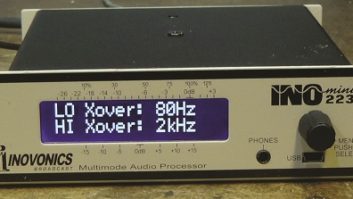Weather is turning colder. Autumn is a perfect time to spend some time at the transmitter site, buttoning things up for the colder seasons.
As you drive up to each facility, check your gate lock. Bring along a can of penetrating oil to spray inside the lock. You will appreciate how quick you can get into the property when the temperature is in the single digits.
If your locks are old, you might consider switching to the four-digit combination locks that Master manufactures. You can set your own combination, which will cut down on the number of keys you carry, to say nothing of being able to keep the site secure should you need to change the combination.
Another good addition is a sign advising whom to contact in case of an emergency – if your gate or fence does not already have one.
To avoid vandalism, keep the station logo or calls off the sign – your cell phone or pager number can work. While you’re at it, notify both the local police precinct and the fire/rescue department of the contact numbers.
. . .
(click thumbnail)Figure 1: Damage doorLooking for really good protection? Take a few station caps or T-shirts along with your visit to civil service authorities. The fire, rescue, police or, for that matter, the power or utility companies will appreciate your kindness.
When I was chiefing stations, I had direct access to both power and phone company emergency repair – talk about looking like you can pull a rabbit from any hat! It only takes a minute and the payback is a hundredfold.
Keep a critical eye open as you drive up to the building.
Figure 1 shows the deterioration of a door, damaged by water. The door has rotted from within and will shortly provide access to either animals or vandals. These are the kind of problems of which you need to be aware.

. . .
(click thumbnail)Figure 2: Austin Ring transformer damage.As you walk to the tower, watch for obvious burns, arcing or similar damage. In addition to causing the tower lights to fail, the burned Austin Ring transformer, seen in Figure 2, shorted, causing the directional array to go whacky.
Remember, when you spot a problem with a directional array, don’t adjust the phasor until you have made a thorough inspection of the site.
The burned transformer in Figure 2 was due to a broken ground strap. The strap shorted the windings of the transformer and you can see the results.

. . .
Yes, some arrays are just simply unstable. Others stay rock steady and a major shift in the antenna monitor parameters usually points to a component failure — perhaps a capacitor has blown, a coil winding shorted or a J-plug is missing.
I remember a phasor where the J-plug jacks were mounted on the roof of the phasor. This placed the J-plugs in an upside-down position. They were always falling out, shutting the station off.
We finally used wire ties to hold them in place. The lesson here is to look for the obvious, first.
Figure 3 is a violation waiting to happen. The FCC inspectors don’t like exposed radials. Neither do animals – or for that matter, dirt bikes.
(click thumbnail)Figure 3: Exposed ground radials invite a citation.
Want to ruin your AM coverage in a hurry? Then it is possible lose half your radials because deer have trampled them or a dirt bike track runs right over them when they are exposed.
It’s nice to see the condition of the radials when they are exposed, but after you’ve determined they are in good shape, get them covered up.
The small plants growing outside the tower fence can be curbed. Cover the earth with landscaping fabric or black plastic, then a cover of pea gravel. Sand, as shown in the photo, works too, except the wind can slowly remove it, making the task of keeping the radials covered a never ending one.

. . .
As you inspect the ground system at the base of your tower, look for loose or broken connections – this includes grounds on FM towers, too.
Many AM sites have tied their galvanized fencing into the ground system. Inspect these connections, especially where dissimilar metals are used.
Remember that any ground radials, strap or screen repairs are to be made with silver solder. Use a MAPP gas torch – available at hardware stores. It’s simpler to use than an acetylene torch and produces a hotter flame than standard hand-held gas torches, so the job gets done quicker.
(click thumbnail)Grounding the fence at an AM tower site.
We’ve only begun to touch on damaged components. Next time we’ll inspect them more closely.

. . .
In our recent NAB Transmitter workshop, Martin Cooper of Transcom, a used transmitter buyer and reseller, offered some tips on getting the most out of your used transmitter.
First, any transmitter built prior to 1975 has a limited value in today’s market. A 10-year-old transmitter may return 10 percent or more of its new value, depending on its condition. A 20-year-old transmitter may return only 5 percent.
Cooper warned that a station couldn’t obviate or transfer its responsibility with regard to PCB oil filled devices (capacitors and transformers) found in many older transmitters.
His advice? Get your local power company to remove and dispose of them – don’t sell a transmitter to anyone with PCB capacitors or transformers inside.
What’s the biggest factor that determines resale cost? Cooper says adequate maintenance, cleanliness and properly documented changes top the list. Surprisingly, an accurate tech manual and schematics figure into the overall value – as do spare parts.
Submissions for this column are encouraged and qualify for SBE recertification credit. Fax your submission to (703) 323-8044 or send e-mail to [email protected]









